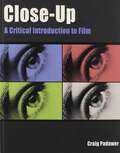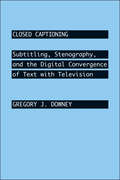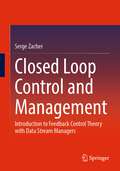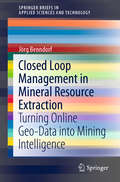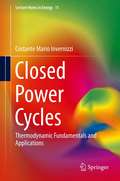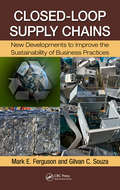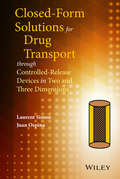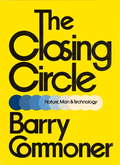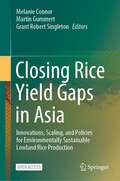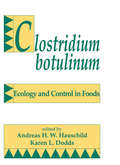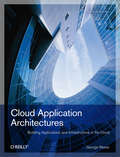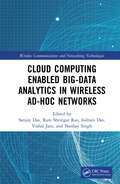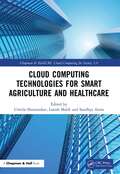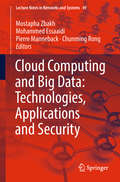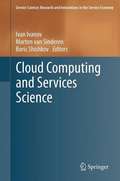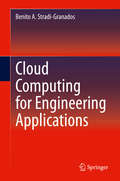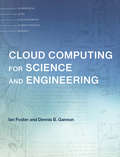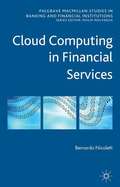- Table View
- List View
Close to the Machine: Technophilia and Its Discontents
by Ellen UllmanWith a New Introduction by Jaron Lanier A Salon Best Book of the Year In 1997, the computer was still a relatively new tool---a sleek and unforgiving machine that was beyond the grasp of most users. With intimate and unflinching detail, software engineer Ellen Ullman examines the strange ecstasy of being at the forefront of the predominantly male technological revolution, and the difficulty of translating the inherent messiness of human life into artful and efficient code. Close to the Machine is an elegant and revelatory mediation on the dawn of the digital era.
Close to the Machine: Technophilia and its Discontents
by Ellen UllmanA candid account of the life of a software engineer who runs her own computer consulting business in San Francisco. What is it about the numerical, seemingly inhuman world of computing that holds such powerful, wholly human allure?
Close-Up: A Critical Introduction to Film
by Craig PadawerClose-Up: A Critical Introduction to Film 1st Edition
Closed Captioning: Subtitling, Stenography, and the Digital Convergence of Text with Television (Johns Hopkins Studies in the History of Technology)
by Gregory J. DowneyThis engaging study traces the development of closed captioning—a field that emerged in the 1970s and 1980s from decades-long developments in cinematic subtitling, courtroom stenography, and education for the deaf. Gregory J. Downey discusses how digital computers, coupled with human mental and physical skills, made live television captioning possible. Downey's survey includess the hidden information workers who mediate between live audiovisual action and the production of visual track and written records. His work examines communication technology, human geography, and the place of labor in a technologically complex and spatially fragmented world. Illustrating the ways in which technological development grows out of government regulation, education innovation, professional profit-seeking, and social activism, this interdisciplinary study combines insights from several fields, among them the history of technology, human geography, mass communication, and information studies.
Closed Loop Control and Management: Introduction to Feedback Control Theory with Data Stream Managers
by Serge ZacherThe block diagrams as engineering means for closed loop control, which have been established by classic control theory for decades, are replaced in the above mentioned book by networks, the signals are replaced by data. It corresponds to the „Industry 4.0“ and to the structure of today’s automatic control systems. Thereby a classic closed loop is treated not isolated from other elements of nowadays automation like bus communication and process logical control, and is completed in proposed book with new control elements, so called data stream managers (DSM). The proposed book treats the control theory systematically like it is done in classical books considering the new concept of data management. The theory is accompanied in the book with examples, exercises with solutions and MATLAB®-simulations.
Closed Loop Management in Mineral Resource Extraction: Turning Online Geo-Data into Mining Intelligence (SpringerBriefs in Applied Sciences and Technology)
by Jörg BenndorfThis book describes an innovative closed-loop concept that allows the feedback of online data from operational monitoring to create mining intelligence. The application of this concept promises significant improvements in economic and environmental key performance indicators for any mining operation.Combining theory with industrial case studies, the book guides readers through this process by providing theoretical background, addressing practical issues related to operational implementation, and illustrating the impact on selected examples. This new concept is presented using the example of a bulk and gold mining application, but is applicable at any mine where grade control is important.The book is of interest to industrial professionals involved in operational monitoring, mining intelligence, and mine planning optimization, as well as to researchers and academics in the field of applied geostatistics.
Closed Power Cycles: Thermodynamic Fundamentals and Applications (Lecture Notes in Energy #11)
by Costante Mario InvernizziWith the growing attention to the exploitation of renewable energies and heat recovery from industrial processes, the traditional steam and gas cycles are showing themselves often inadequate. The inadequacy is due to the great assortment of the required sizes power and of the large kind of heat sources. Closed Power Cycles: Thermodynamic Fundamentals and Applications offers an organized discussion about the strong interaction between working fluids, the thermodynamic behavior of the cycle using them and the technological design aspects of the machines. A precise treatment of thermal engines operating in accordance with closed cycles is provided to develop ideas and discussions strictly founded on the basic thermodynamic facts that control the closed cycles operation and design. Closed Power Cycles: Thermodynamic Fundamentals and Applications also contains numerous examples which have been carried out with the help of the Aspen Plus®R program. Including chapters on binary cycles, the organic Rankine cycle and real closed gas cycles, Closed Power Cycles: Thermodynamic Fundamentals and Applications acts a solid introduction and reference for post-graduate students and researchers working in applied thermodynamics and energy conversion with thermodynamic engines.
Closed-Loop Supply Chains: New Developments to Improve the Sustainability of Business Practices (Supply Chain Integration Modeling, Optimization and Application)
by Mark E. Ferguson Gilvan C. SouzaClosed-loop supply chain activities such as remanufacturing, recycling, dismantling for spare parts, and reverse logistics have helped many companies tap into new revenue streams by finding secondary markets for their products, all while reducing their overall carbon footprint. Written by academic experts, in language that is accessible to practitioners, this authoritative resource examines recent research and case studies of companies running profitable reuse/remanufacture operations in various industries. It illustrates profitable practices in returned and recovered products, clearly explaining how to: design a reverse logistics network, conduct production planning, implement effective marketing strategies, and apply closed-loop supply chain strategies in industries besides manufacturing. From product development to materials to assembly and profitability, this complete resource explores the impact of these processes across all aspects of the supply chain.
Closed-form Solutions for Drug Transport through Controlled-Release Devices in Two and Three Dimensions
by Laurent Simon Juan OspinaProvides solutions for two- and three-dimensional linear models of controlled-release systems Real-world applications are taken from used to help illustrate the methods in Cartesian, cylindrical and spherical coordinate systems Covers the modeling of drug-delivery systems and provides mathematical tools to evaluate and build controlled-release devices Includes classical and analytical techniques to solve boundary-value problems involving two- and three-dimensional partial differential equations Provides detailed examples, case studies and step-by-step analytical solutions to relevant problems using popular computational software
Closing Circle
by Barry CommonerFrom Chapter One:This book . . . begins with the ecosphere, the setting in which civilization has done its great--and terrible--deeds. Then it moves to a description of some of the damage we have done to the ecosphere--to the air, the water, the soil. However, by now such horror stories of environmental destruction are familiar, even tiresome. Much less clear is what we need to learn from them, and so I have chosen less to shed tears for our past mistakes than to try to understand them. Most of this book is an effort to discover which human acts have broken the circle of life, and why. I trace the environmental crisis from its overt manifestations in the ecosphere to the ecological stresses which they reflect, to the faults in productive technology--and in its scientific background--that generate these stresses, and finally to the economic, social, and political forces which have driven us down this self-destructive course. All this in the hope--and expectation--that once we understand the origins of the environmental crisis, we can begin to manage the huge undertaking of surviving it.
Closing Rice Yield Gaps in Asia: Innovations, Scaling, and Policies for Environmentally Sustainable Lowland Rice Production
by Martin Gummert Melanie Connor Grant Robert SingletonThis open access book contributes not only to the scientific literature on sustainable agricultural development and in particular rice agriculture but also is highly valuable to assist practitioners, projects, and policymakers due to its sections on reducing carbon footprint, agricultural innovations, and lessons learned from a multi-country/multi-stages development project. The scope of the book is conceived as a detailed documentation of the implementation, dissemination, and impact of the CORIGAP project in Sri Lanka, Myanmar, Thailand, China, Vietnam, and Indonesia, with spill-over to Cambodia and the Philippines. It pulls together actionable research findings with the experience of bringing these findings into use. The aim of the book is to provide a wide array of pathways to impact for sustainable rice production in lowland irrigated rice-based agricultural systems. The book is written by local actors of the rice value chain, researchers, and engineers working on a range of best management practices, climate-smart rice production innovations, knowledge translation, and dissemination, as well as decision-making and policy aspects. It is envisioned that the contents of the book can be translated into messages that can help farmers, extension workers, policymakers, and funders of agricultural development, decide on implementing best management practices and climate-smart technologies in their agroecological systems by presenting the technological/practical options along the rice value chain and the partnerships and business models required for their implementation. The book is aimed at practitioners, extension specialists, researchers, and engineers interested in information on current best management practices, sustainable, and climate-smart rice production and constraints that need further investigation. Furthermore, the book is also aimed at policymakers and agricultural development funders required by public opinion and legally binding agreements to reduce greenhouse gas emissions, conserve biodiversity and increase agroecological practices, who are looking for research-based evidence to guide policymaking and implementation.
Closing the Gap Between Practice and Research in Industrial Engineering (Lecture Notes in Management and Industrial Engineering)
by Elisabeth Viles Marta Ormazábal Alvaro LleóThis book presents the proceedings of the XXII International Conference on Industrial Engineering and Operations Management, International IIE Conference 2016, and International AIM Conference 2016. This joint conference is a result of an agreement between ADINGOR (Asociaci#65533;n para el Desarrollo de la Ingenier#65533;a de Organizaci#65533;n), ABEPRO (Associa#65533;#65533;o Brasileira de Engenharia de Produ#65533;#65533;o), AIM (European Academy for Industrial Management) and the IIE (Institute of Industrial Engineers), and took place at TECNUN-School of Engineering (San Sebasti#65533;n, Spain) from July 13th to 15th, 2016. The book includes the latest research advances and cutting-edge analyses of real case studies in Industrial Engineering and Operations Management from diverse international contexts, while also identifying concrete business applications for the latest findings and innovations in operations management and the decisions sciences.
Clostridium Botulinum: Ecology and Control in Foods (Food Science And Technology Ser. #54)
by HauschildAn in-depth resource addressing the ecology of Clostridium botulinum which affects the degree of food contamination, and its control in various foods. The text summarizes worldwide data on this organism in food and the environment and the principles of its control in specific foods and products.
Cloud Application Architectures: Building Applications and Infrastructure in the Cloud (Theory in Practice (O'Reilly))
by George ReeseIf you're involved in planning IT infrastructure as a network or system architect, system administrator, or developer, this book will help you adapt your skills to work with these highly scalable, highly redundant infrastructure services. While analysts hotly debate the advantages and risks of cloud computing, IT staff and programmers are left to determine whether and how to put their applications into these virtualized services. Cloud Application Architectures provides answers -- and critical guidance -- on issues of cost, availability, performance, scaling, privacy, and security. With Cloud Application Architectures, you will:Understand the differences between traditional deployment and cloud computingDetermine whether moving existing applications to the cloud makes technical and business senseAnalyze and compare the long-term costs of cloud services, traditional hosting, and owning dedicated serversLearn how to build a transactional web application for the cloud or migrate one to itUnderstand how the cloud helps you better prepare for disaster recoveryChange your perspective on application scalingTo provide realistic examples of the book's principles in action, the author delves into some of the choices and operations available on Amazon Web Services, and includes high-level summaries of several of the other services available on the market today. Cloud Application Architectures provides best practices that apply to every available cloud service. Learn how to make the transition to the cloud and prepare your web applications to succeed.
Cloud Computing Enabled Big-Data Analytics in Wireless Ad-hoc Networks (Wireless Communications and Networking Technologies)
by Sanjoy DasThis book discusses intelligent computing through Internet of Things (IoT) and Big Data in vehicular environments in a single volume. It covers important topics, such as topology-based routing protocols, heterogeneous wireless networks, security risks, software-defined vehicular ad-hoc networks, vehicular delay tolerant networks, and energy harvesting for WSNs using rectenna. Features Covers applications of IoT in Vehicular Ad-hoc Network (VANETs) Discusses use of machine learning and other computing techniques for enhancing performance of networks Explains game theory-based vertical handoffs in heterogeneous wireless networks Examines monitoring and surveillance of vehicles through the vehicular sensor network Investigates theoretical approaches on software-defined VANET The book is aimed at graduate students and academic researchers in the fields of electrical engineering, electronics and communication engineering, computer science, and engineering.
Cloud Computing Technologies for Smart Agriculture and Healthcare (Chapman & Hall/CRC Cloud Computing for Society 5.0)
by Urmila ShrawankarThe Cloud is an advanced and fast-growing technology in the current era. The computing paradigm has changed drastically. It provided a new insight into the computing world with new characteristics including on-demand, virtualization, scalability and many more. Utility computing, virtualization and service-oriented architecture (SoA) are the key characteristics of Cloud computing. The Cloud provides distinct IT services over the web on a pay-as-you-go and on-demand basis. Cloud Computing Technologies for Smart Agriculture and Healthcare covers Cloud management and its framework. It also focuses how the Cloud computing framework can be integrated with applications based on agriculture and healthcare. Features: Contains a systematic overview of the state-of-the-art, basic theories, challenges, implementation, and case studies on Cloud technology Discusses of recent research results and future advancement in virtualization technology Focuses on core theories, architectures, and technologies necessary to develop and understand the computing models and its applications Includes a wide range of examples that uses Cloud technology for increasing farm profitability and sustainable production Presents the farming industry with Cloud technology that allows it toaggregate, analyze, and share data across farms and the world Includes Cloud-based electronic health records with privacy and security features Offers suitable IT solutions to the global issues in the domain of agriculture and health care for society This reference book is aimed at undergraduate and post-graduate programs. It will also help research scholars in their research work. This book also benefits like scientists, business innovators, entrepreneurs, professionals, and practitioners.
Cloud Computing and Big Data: Technologies, Applications and Security (Lecture Notes in Networks and Systems #49)
by Mostapha Zbakh Mohammed Essaaidi Pierre Manneback Chunming RongThis book addresses topics related to cloud and Big Data technologies, architecture and applications including distributed computing and data centers, cloud infrastructure and security, and end-user services. The majority of the book is devoted to the security aspects of cloud computing and Big Data. Cloud computing, which can be seen as any subscription-based or pay-per-use service that extends the Internet’s existing capabilities, has gained considerable attention from both academia and the IT industry as a new infrastructure requiring smaller investments in hardware platforms, staff training, or licensing software tools. It is a new paradigm that has ushered in a revolution in both data storage and computation. In parallel to this progress, Big Data technologies, which rely heavily on cloud computing platforms for both data storage and processing, have been developed and deployed at breathtaking speed. They are among the most frequently used technologies for developing applications and services in many fields, such as the web, health, and energy. Accordingly, cloud computing and Big Data technologies are two of the most central current and future research mainstreams. They involve and impact a host of fields, including business, scientific research, and public and private administration. Gathering extended versions of the best papers presented at the Third International Conference on Cloud Computing Technologies and Applications (CloudTech’17), this book offers a valuable resource for all Information System managers, researchers, students, developers, and policymakers involved in the technological and application aspects of cloud computing and Big Data.
Cloud Computing and Services Science: Second International Conference, Closer 2012, Porto, Portugal, April 18-21, 2012. Revised Selected Papers (Service Science: Research and Innovations in the Service Economy #367)
by Boris Shishkov Marten Van Sinderen Ivan IvanovThe Cloud Computing and Services Science book comprises a collection of the best papers presented at the International Conference on Cloud Computing and Services Science (CLOSER), which was held in The Netherlands in May 2011. In netting papers from the conference researchers and experts from all over the world explore a wide-ranging variety of the emerging Cloud Computing platforms, models, applications and enabling technologies. Further, in several papers the authors exemplify essential links to Services Science as service development abstraction, service innovation, and service engineering, acknowledging the service-orientation in most current IT-driven structures in the Cloud. The Cloud Computing and Services Science book is organized around important dimensions of technology trends in the domain of cloud computing in relation to a broad scientific understanding of modern services emerging from services science. The papers of this book are inspired by scholarly and practical work on the latest advances related to cloud infrastructure, operations, security, services, and management through the global network. This book includes several features that will be helpful, interesting, and inspirational to students, researchers as well as practitioners. Professionals and decision makers working in this field will also benefit from this book
Cloud Computing for Engineering Applications
by Benito A. Stradi-GranadosThis book explains the use of cloud computing systems for engineering applications to satisfy the need for enterprise level, state-of-the-art computational capacities at an affordable cost. As huge costs are involved in the maintenance and timely renovation of computational capabilities, particularly for projects that require significant computational capacity, cloud services can achieve considerable savings for users and organizations engaged in engineering research and development. Dr. Stradi-Granados explains how to extract a maximum value from every dollar invested in cloud computer server. The types of facilities located around the world that lease their resources to customers interested in reducing the internal overhead and implementation time. The volume features chapters on model generation, motion studies, and prototyping is ideal for students, researchers, practitioners, and facility's managers across a range of engineering domains.
Cloud Computing for Logistics (Lecture Notes in Logistics)
by Michael Hompel Jakob Rehof Oliver WolfThis edited monograph brings together research papers covering the state of the art in cloud computing for logistics. The book includes general business object models for intralogistics as well as user-friendly methods for logistics business process design. It also presents a general template for logistics applications from the cloud. The target audience primarily comprises researchers and experts in the field, but the book will also be beneficial for graduate students.
Cloud Computing for Science and Engineering (Scientific and Engineering Computation)
by Ian Foster Dennis B. GannonA guide to cloud computing for students, scientists, and engineers, with advice and many hands-on examples.The emergence of powerful, always-on cloud utilities has transformed how consumers interact with information technology, enabling video streaming, intelligent personal assistants, and the sharing of content. Businesses, too, have benefited from the cloud, outsourcing much of their information technology to cloud services. Science, however, has not fully exploited the advantages of the cloud. Could scientific discovery be accelerated if mundane chores were automated and outsourced to the cloud? Leading computer scientists Ian Foster and Dennis Gannon argue that it can, and in this book offer a guide to cloud computing for students, scientists, and engineers, with advice and many hands-on examples. The book surveys the technology that underpins the cloud, new approaches to technical problems enabled by the cloud, and the concepts required to integrate cloud services into scientific work. It covers managing data in the cloud, and how to program these services; computing in the cloud, from deploying single virtual machines or containers to supporting basic interactive science experiments to gathering clusters of machines to do data analytics; using the cloud as a platform for automating analysis procedures, machine learning, and analyzing streaming data; building your own cloud with open source software; and cloud security.The book is accompanied by a website, Cloud4SciEng.org, that provides a variety of supplementary material, including exercises, lecture slides, and other resources helpful to readers and instructors.
Cloud Computing for Smart Education and Collaborative Learning
by Urmila Shrawankar Prerna MishraThe book presents next-generation education technology and the pedagogy of the Education Cloud. It covers technological developments, case studies, innovative research approaches, and solutions for advanced learning paradigms using Internet of Things (IoT), cloud computing, and machine learning to handle various challenges of the smart education system. It discusses cloud architecture, management, and frame- work for education from virtual classrooms and labs. It shows how cloud computing framework can be integrated with fog computing, edge computing, deep learning, and IoT. Illustrates from fundamental theories to practical and sophisticated applications of cloud technology for the education domain Explores e-learning applications through location-independent cloud services to reduce cost Covers result-oriented, real-time solutions for smart, accessible education and its real-time application support Discusses accessible cloud services for people with special needs Presents flexible and scalable cost-effective e-learning architecture and scenario for education technology It serves as a valuable resource for academicians, researchers, and professionals interested in smart education and cloud technology.
Cloud Computing in Financial Services
by Bernardo NicolettiFinancial institutions must become more innovative in the conduct of their business. Cloud computing helps to achieve several objectives: innovative services, re-engineered processes, business agility and value optimization. Research, consultancy practice and case studies in this book consider the opportunities and risks with vendor relationships.
Cloud Computing in Remote Sensing
by Lizhe Wang Yan Ma Jining YanThis book provides the users with quick and easy data acquisition, processing, storage and product generation services. It describes the entire life cycle of remote sensing data and builds an entire high performance remote sensing data processing system framework. It also develops a series of remote sensing data management and processing standards. Features: Covers remote sensing cloud computing Covers remote sensing data integration across distributed data centers Covers cloud storage based remote sensing data share service Covers high performance remote sensing data processing Covers distributed remote sensing products analysis
Cloud Computing with Security and Scalability.: Concepts and Practices
by Naresh Kumar Sehgal Pramod Chandra Bhatt John M. AckenThis book provides readers with an overview of Cloud Computing, starting with historical background on mainframe computers and early networking protocols, leading to current concerns such as hardware and systems security, performance, emerging areas of IoT, Edge Computing, and healthcare etc. Readers will benefit from the in-depth discussion of cloud computing usage and the underlying architectures. The authors explain carefully the “why’s and how’s” of Cloud Computing, so engineers will find this book an invaluable source of information to the topic. This third edition includes new material on Cloud Computing Scalability, as well as best practices for using dynamic cloud infrastructure, and cloud operations management with cost optimizations. Several new examples and analysis of cloud security have been added, including ARM architecture and https protocol.Provides practical guidance for software developers engaged in migrating in-house applications to Public Cloud;Describes for IT managers how to improve their Cloud Computing infrastructures;Includes coverage of security concerns with Cloud operating models;Uses several case studies to illustrate the “why’s and how’s” of using the Cloud;Examples and options to improve Cloud Computing Scalability.


